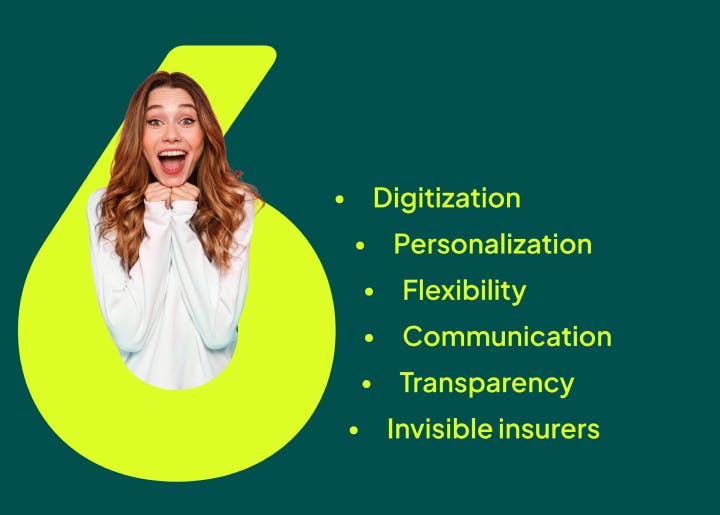6 insurance trends in consumer behaviour you need to know

As of today: The Digital Native in a Digital-First-World.
The term 'digital native' describes a new type of consumer shaped by the digital transformation over the past decade. Not only the needs, knowledge and expectations of today's consumers have expanded significantly, but so has the way technology fits into their everyday lives (Daskal, 2021).
In 2022, the number of Internet users in Germany peaked: almost 57 million people aged 14 and older are online daily. That represents 80% of the country's population (ARD/ZDF Online Studie, 2022). Especially for online purchases, the following figures are interesting: In the 16 -74 age group, 81% are online shoppers (IKT-Erhebung private Haushalte, 2022). These results clearly show that the digital native is an essential part of today's world.
The life of digital natives can be described as full of instant gratification, endless choices, comparison portals, and reviews that are all just a click away. Of course, this development is also changing the consumer's expectations. Above all, this means that companies have to meet the changing and, in some cases, significantly increased demands of their customers to exist on the market.
Of course, digitally influenced consumer behaviour does not stop at the insurance industry. This is where Embedded Insurance comes in.
Embedded ... what?
It's quite simple: Embedded Insurance means that insurance is integrated or embedded with a product or service into an existing customer journey. Therefore, the consumer is offered the right insurance for a product or service directly during the purchasing process. There's no need anymore for hours of research or endless paperwork.
For example, you buy the latest smartphone on the market online. We all know that our everyday companion gets dropped or damaged quite quickly. So, of course, you want to add suitable protection directly while purchasing your new phone. Embedded Insurance makes this possible.
Ordering your smartphone and - at the same time - smartphone insurance tailored to your device and your individual needs. And if something does happen? Then your all-around carefree package should also include the appropriate repair and replacement service.
As you can see, the goal of Embedded Insurance is to seamlessly integrate insurance into existing purchasing processes to create the best and smoothest buying experience for the customer.
Therefore, the insurance industry is steadily evolving from traditional direct and broker sales to embedded insurance. The main reason for this is the changes in consumer behaviour. And these are the trends we are now taking a closer look at.
6 insurance trends in consumer behaviour 2023

1. Digitization
Digitization affects everyone. For this reason, general digitization or digital transformation is probably the most important trend to mention. It affects both consumers and companies at the same time. Is digital development related to the pandemic? We think so, but not only. Even without the pandemic, the digital transformation would have been unstoppable. However, it surely pushed it forward much more rapidly.
So how does digitization affect the consumer? We already talked about the digital native at the beginning. The entire use of information has become more and more digital. People are buying more and more online, and before making a purchase decision, they often research online in terms of ratings and reviews. Throughout this process, consumers demand convenience and comfort above all, which means an uncomplicated and individualized customer journey in all areas is essential. If possible, everything must be accessible with just one click.
Does Embedded Insurance meet these requirements? Yes, of course, because what is more convenient than being offered a suitable insurance policy as an add-on during the purchase process without having to leave the online shop? Exactly, no more extra research into the right insurance cover for a product that has already been purchased. And even better: annoying paperwork is a thing of the past because all documents reach the customer by e-mail in real-time. That's how insurance becomes simple.
2. Personalization
Collecting personal data is one of those things everyone has heard about. However, part of the personalization trend is a new open mindset of today's consumers about their personal data. Consumers are becoming increasingly used to a certain standard. They expect to be offered individualized and personalized products or services and want something that seems unique to them and tailored to their needs. The buying process should also be as personalized as possible to make the customer experience as simple as possible.
What does this mean for Embedded Insurance? It's obvious: the insurance embedded in the product or service is a perfect match for the offer and thus meets the customer's needs. It means that the customer no longer has to worry about looking for a traditional insurance product, which may even end up not being 100% fit for the product.
Cross-selling potential tailored to the customer's needs. We also like to call it a revenue boost.
3. Flexibility
Everyone talks about flexibility. Even in the insurance industry, flexibility is the key to success. Why? Consumers are now in the driver's seat and demand flexibility in every way, not only from their employers, educational institutions, doctors, etc. but also from any company they buy from. Their time is valuable. Accordingly, consumers are increasingly demanding flexibility in every situation so that they can use their valuable time effectively and, above all, respond flexibly at all times.
What are the effects on the insurance industry? Consumers want flexibility during purchasing and most importantly, after a purchase. In other words, customers buy a product or service together with the appropriate insurance. So far, so good. Afterwards, they want to stay flexible and not be stuck with insurance contracts that last for years. The solution: offering customers the option of a monthly cancellation, with the help of embedded insurance. It allows consumers to make a new decision at any time and quickly adapt the insurance to their circumstances or needs.
4. Communication
Communication is half the battle. We know it from everyday situations: without communication, things don't work out, and misunderstandings and long processes of coordination can occur. Why should it be any different in the insurance industry? Exactly.
That's why consumers demand more and, above all, good communication from their insurer. It is important to keep an eye on the entire customer journey and all touch points. By staying in touch with the customer at every touch point, the buying experience can become truly exceptional for the customer. As a result, companies can build deep and more personal relationships with customers through more communication. And that improves the customer journey in the long run.
One could say: It takes more communication in the right place and at the right time.
5. Transparency
Don't we all wish for more transparency? Looking at consumer behaviour in recent years, we can see that while consumers are becoming more open regarding their data, they also want full transparency from the companies they buy from.
Incidents of data misuse in recent years brought the debate to a head. One well-known example is Facebook's Cambridge Analytica case. In 2019, Facebook misused users' personal data and, as a result, was fined $5 billion (Romm, 2019).
Keyword: trust. Consumers are fundamentally willing to trust companies; like anywhere else, trust must be earned. How can companies do that? With Embedded Insurance, companies include the insurance directly in their offer, and thus all associated important documents, such as the general terms and conditions of insurance, durations, and exclusions. The documents must be fully accessible to customers before the conclusion and with the help of interfaces, are also forwarded to the customer digitally and in real-time after the conclusion.
6. The new insurers
What is your first thought when you think of classic insurance companies? Perhaps you think of fixed structures, long processes, and a lot of paperwork. Consumers feel the same. Many see insurance as quite necessary, but don't want to worry about it. As a result, less insurance is being purchased for the things consumers love, even though they want it.
Embedded Insurance can help. Once companies embed insurance into their offerings and customer journey, they create a whole new and easy way for customers to access insurance. The companies are thus the new insurers and the insurance companies step into the background. Keyword: "Invisible Insurers".
Conclusion
Consumers' needs and behaviour patterns have changed drastically in recent years. They have instant access to more and more information, and technology is their everyday companion. This development also affects the insurance industry. That's why, in this blog, we've taken a closer look at the 6 most important trends in consumer behaviour and how they affect the insurance industry and companies.
Consumers are demanding all-inclusive packages without having to worry about separate insurance coverage for their products. To help companies meet these demands, we believe there is only one solution: embedded insurance can be the next big thing for businesses.
Sources
ARD/ZDF-Onlinestudie 2022: Mediale Inhalte verstärken Internetnutzung (2022). Retrieved on 03.03.2023 from https://www.ard-media.de/media-perspektiven/studien/ardzdf-onlinestudie/
Daskal, T. (2021, 13. März). Trends That Will Shape The Future Of Insurance. Forbes. Retrieved on 03.03.2023, from https://www.forbes.com/sites/forbestechcouncil/2021/05/13/trends-that-will-shape-the-future-of-insurance/?sh=3695c2485182
Romm, T. (2019, 13. Juli). Facebook fined US5 billion in Cambridge Analytica privacy probe. Sydney Morning Herald. Retrieved on 03.03.2023 from https://www.smh.com.au/world/north-america/facebook-fined-us5-billion-in-cambridge-analytica-privacy-probe-20190713-p526xb.html
Statistisches Bundesamt (Destatis) (2023, 06. Februar). Erhebung über die private Nutzung von Informations- und Kommunikationstechnologien: IKT 2022 Mikrozensus-Unterstichprobe zur Internetnutzung. Retrieved on 03.03.2023 from https://www.destatis.de/DE/Methoden/Qualitaet/Qualitaetsberichte/Einkommen-Konsum-Lebensbedingungen/ikt-private-haushalte-2022.pdf?__blob=publicationFile#:~:text=Erhebungszeitraum%20erstreckte%20sich%20bei%20der, Juni%202022.&text=J%C3%A4hrlich%20seit%202006%20(IKT%2DPiloterhebungen%3A%20seit%202003).
Get in touch
Want to know how hepster has taken embedded insurance to the next level? Alright - talk to us.


